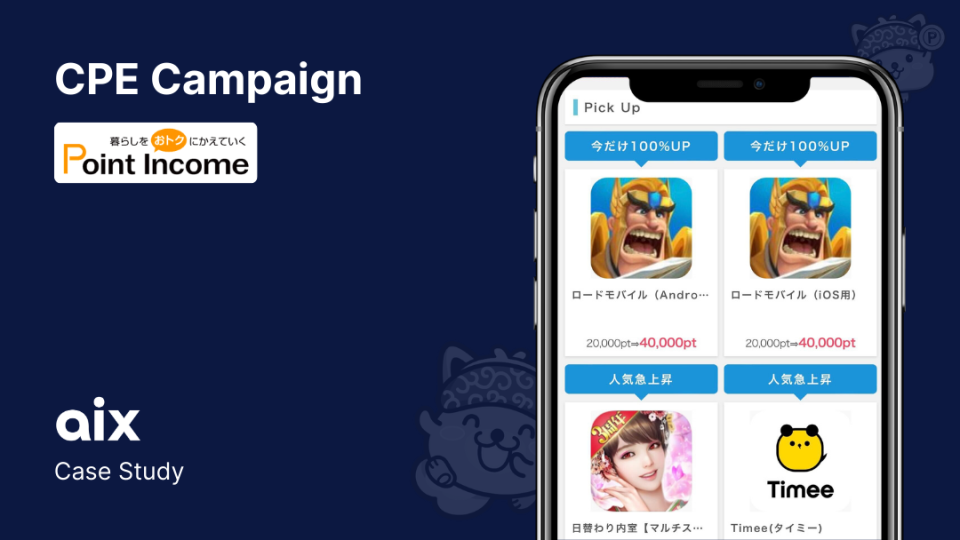Introduction
Japan’s mobile advertising market is one of the most lucrative and competitive in the world. With high smartphone penetration and a user base that demonstrates strong spending habits, mobile marketers must constantly adapt to new trends and technologies to stay ahead.
As a UA (User Acquisition) manager, understanding the latest developments in this evolving landscape is crucial for maximizing campaign performance and achieving sustainable growth.

Market Growth and Spending Trends
The Japanese mobile advertising market continues to expand, with total ad spend reaching 17.9 billion USD, making it the third-largest globally after the US and China (Source: Data.ai, 2023).
This growth is fueled by increased mobile app usage, rising consumer engagement with digital content, and the shift toward performance-based marketing strategies.

Key Insights:
- High-Value Market: Japan’s mobile Average Revenue Per User (ARPU) is 149 USD, which is nearly three times higher than in the US (Source: Business of Apps, 2021).
- Diverse and Engaged Users: 90.1% of Japan’s population uses smartphones, providing an extensive reach for advertisers (Source: Ministry of Internal Affairs and Communications).
- Gaming Dominates: Mobile gaming continues to be a dominant sector, accounting for 60%+ of total app revenue in Japan.
Shift from CPI to CPE Models
Traditionally, Cost-Per-Install (CPI) campaigns were the go-to strategy for user acquisition in Japan. However, there has been a noticeable shift toward Cost-Per-Engagement (CPE) models, driven by advertisers seeking higher retention rates and better quality users based on the ROAS or ROI.

Why CPE is Becoming the Standard:
✅ Better ROI: Advertisers pay only for meaningful user interactions rather than just installs.
✅ Higher Retention: Engaged users demonstrate stronger long-term retention and monetization potential.
✅ Fraud Reduction: CPE campaigns minimize the risk of fraudulent installs and bot-driven traffic.
The Rise of Reward-Based Advertising to the oversea app service players in Japan.
Reward-based advertising has gained traction in Japan, especially through platforms like Rocket A, which incentivizes users with redeemable points. This model effectively lowers the barrier for initial engagement while fostering a habit-forming user experience based on points.
One of the driving forces behind reward-based advertising in Japan is the stablization of Poikatsu (ポイ活) culture, where users actively participate in point accumulation activities through various apps and services.
Poikatsu enthusiasts engage with mobile ads and reward-based promotions to maximize their savings and benefits, creating a highly engaged and conversion-ready audience for advertisers.
Rocket A Key Benefits:
🎯 Increases Install-to-Active-Only Japanese Territory User Conversion
📈 Improves KPI with long CPE campaign (Day 30 Retention by up to 45%, Data from Rocket A’s campaign performance) without any media or traffice intermediates.
🔒 Drives Sustainable Growth in High-LTV Users
User Privacy and Compliance in Japan
With increasing concerns about data privacy, Advertisers must stay compliant with regulations such as Japan’s Act on the Protection of Personal Information (APPI) and Apple’s App Tracking Transparency (ATT) framework.
Privacy-first advertising is now the industry standard, requiring a shift toward contextual targeting and first-party data strategies.
Influencer & Social Media UA Strategies
Influencer marketing continues to be a dominant force in Japan, especially on Instagram, TikTok, and YouTube. Many game publishers and app developers are leveraging micro-influencers to drive organic growth.
Key Considerations for Influencer UA:
- Authenticity Matters: Japanese users trust peer recommendations more than traditional ads.
- Short-Form Video Dominates: TikTok-style promotions drive higher engagement rates.
- Community Engagement: Building brand loyalty through interactive content.
The Growth of Playable & Engagement Ads
As Japanese users demand more engaging ad experiences, playable ads and interactive formats are becoming increasingly popular. These ads allow users to experience an app or game before installation, leading to higher conversion rates.
Performance Metrics & Optimization Trends
Modern UA managers in Japan focus on deeper performance ROAS, ROI, LTV analysis beyond traditional CPI,CTR metrics. The most critical KPIs include:
- Retention Rates (D1, D7, D30)
- Return on Ad Spend (ROAS)
- Customer Lifetime Value (LTV)
- Engagement-Based Metrics (time spent, in-app actions)
Future Outlook & Predictions
The Japanese mobile advertising market will continue to evolve, with the following trends expected to shape the future: 🚀
Increased Investment in CPE & Engagement-Driven UA 📲
Greater Adoption of Data & Automation in Ad Optimization 📡 Focus on Privacy-First Marketing & First-Party Data
For UA managers operating in Japan, staying ahead of these trends is crucial for maximizing user acquisition efficiency and long-term growth.
By leveraging CPE models, AI-driven strategies, influencer marketing, and reward-based CPE advertising, advertisers can acquire high-quality Japanese users while optimizing their ROI.
For businesses looking to scale in Japan, partnering with trusted advertising platforms like Rocket A ensures transparent, efficient, and high-performance UA campaigns tailored to the unique characteristics of the Japanese market.
Soft Launch Commemorative Special Offer

To promote the soft launch, Rocket A is introducing a limited-time offer for both existing partners and new clients. T
🚀 Special Offer Details
・$1,000 discount applied when achieving over $5,000 in performance, reducing initial risk and allowing for an efficient validation of Japanese user acquisition.












